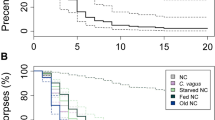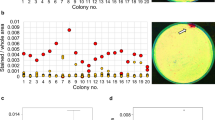Abstract
Ant corpses, besides representing threat of infection by pathogens and parasites, can also be used during interspecific conflicts to inhibit the activity of the attacked colony, or they can be consumed as food. In the view of the former, the signal properties of corpses can be manifold. Besides discriminating nestmates and foes, the corpses of different ant species may act as cues for foragers, signaling the presence of other rival species, and triggering appropriate responses (e.g., alarm, retreat or foraging). In our study, we examined the responses of the facultative slave-maker Formica sanguinea and those of the obligate Polyergus rufescens towards corpses of nestmates, non-nestmate conspecifics, heterospecific slave-makers and their slaves, and corpses of non-enslaved host species under laboratory conditions. Both dulotic species responded differently to corpses of different origin. In F. sanguinea, the most intensive response was elicited by the corpses of P. rufescens and its slave, but also the corpses of non-nestmate conspecifics and their slaves elicited many adverse responses. In P. rufescens, the corpses of non-nestmate conspecifics and their slaves elicited the most adverse response. Both dulotic species distinguished corpses of their slaves from corpses of non-enslaved hosts. Based on our results, ant corpses are not meaningless objects scattered in the field, but cues carrying information that trigger different behavioral responses, and in F. sanguinea they can even represent an important food source.








Similar content being viewed by others
References
Bartoń K (2013) MuMIn: Multi-model inference. R package version 1.9.13. http://CRAN.R-project.org/package=MuMIn. Published online 29 October 2013
Bates D, Maechler M, Bolker B, Walker S (2013) lme4: Linear mixed-effects models using Eigen and S4. R package version 1.0–5 http://CRAN.R-project.org/ package = lme4. Published online 25 October 2013
Bhatkar A, Whitcomb WH (1970) Artificial diet for rearing various species of ants. Fla Entomol 53:229–232
Bono JM, Gordon ER, Antolin MF, Herbers JM (2006) Raiding activity of an obligate (Polyergus breviceps) and two facultative (Formica puberula and F. gynocrates) slave-making ants. J Insect Behav 19:429–446
Boomsma JJ, Schmid-Hempel P, Hughes WOH (2005) Life histories and parasite pressure across the major groups of social insects. In: Fellowes M, Holloway GR (eds) Insect evolutionary ecology, royal entomological society. CABI Publishing, Cambridge, pp. 139–175
Brandt M, Heinze J, Schmitt T, Foitzik S (2005) A chemical level in the coevolutionary arms race between an ant social parasite and its hosts. J Evolution Biol 18:576–586
Buschinger A (2009) Social parasitism among ants: a review (Hymenoptera: Formicidae). Myrmecol News 12:219–235
Carlin NF, Johnston AB (1984) Learned enemy specification in the defense recruitment system of an ant. Naturwissenschaften 71:156–157
Choe DH, Rust MK (2008) Horizontal transfer of insecticides in laboratory colonies of the argentine ant (Hymenoptera: Formicidae). J Econ Entomol 101:1397–1405
Choe DH, Millar JG, Rust MK (2009) Chemical signal associated with life inhibits necrophoresis in Argentine ants. P Natl Acad Sci USA 109:8251–8255
Chouvenc T, Robert A, Sémon E, Bordereau C (2012) Burial behaviour by dealates of the termite Pseudacanthotermes spiniger (Termitidae, Macrotermitinae) induced by chemical signals from termite corpses. Insect Soc 59:119–125
Cournault L, de Biseau JC (2009) Hierarchical perception of fertility signals and nestmate recognition cues in two dolichoderine ants. Behav Ecol Sociobiol 63:1635–1641
Cremer S, Armitage SAO, Schmid-Hempel P (2007) Social immunity. Curr Biol 17:693–702
Czechowski W (1976) Cmentarzyska mrówek [Ant cemeteries]. Przegl Zool 20:417–427 (in polish)
Czechowski W (1985) Competition between Myrmica laevinodis Nyl. and Lasius niger (L.) (Hymenoptera, Formicidae). Ann Zool 39:153–173
Czechowski W (1996) Colonies of hybrids and mixed colonies; interspecific nest take over in wood ants (Hymenoptera, Formicidae). Mem Zoologi 50:1–116+20
Czechowski W (2006) The route of Formica polyctena Först. as a factor promoting emancipation of Formica fusca L. slaves from colonies of Polyergus rufescens (Latr.) (Hymenoptera: Formicidae). Pol J Ecol 54:159–162
Czechowski W (2007a) Do Polyergus rufescens (Latr.) and Formica sanguinea Latr. (Hymenoptera: Formicidae) share resources of slave species with each other? Pol J Ecol 55:169–173
Czechowski W (2007b) Behavioural and socially parasitic relations between Polyergus rufescens (Latr.) and Formica polyctena Först. (Hymenoptera: Formicidae). Entomol Fennica 18:54–64
Czechowski W (2008) Around nest cemeteries of Myrmica schenky EM. (Hymenoptera: Formicidae): their origin and a possible significance. Pol J Ecol 56:359–363
Czechowski W, Markó B, Godzinska EJ (2009) Corpse carrying in ants (Hymenoptera: Formicidae) behavioral side effect of aggressive arousal or competitive signaling? Pol J Ecol 57:341–352
Czechowski W, Radchenko A, Czechowska W, Vepsäläinen K (2012) The ants (Hymenoptera, Formicidae) of Poland with reference to the myrmecofauna of Europe. MIZ PAS, Warszawa, p. 496
d’Ettorre P, Heinze J (2001) Sociobiology of slave-making ants. Acta Ethol 3:67–82
De Bruyn G, Mabelis AA (1972) Predation and aggression as possible regulatory mechanisms in Formica. Ekol Pol 20:93–101
Diez L, Deneubourg JL, Detrain C (2012) Social prophylaxis through distant corpse removal in ants. Naturwissenchaften. doi:10.1007/s00114-012-0965-6
Diez L, Le Borgne H, Lejeune P, Detrain C (2013a) Who brings out the dead? Necrophoresis in the red ant, Myrmica rubra. Anim Behav 6:1259–1264
Diez L, Moquet L, Detrain C (2013b) Post-mortem changes in chemical profile and their influence on corpse removal in ants. J Chem Ecol. doi:10.1007/s10886-013-0365-1
Erdős L, Gallé R, Körmöczi L, Bátori Z (2013) Species composition and diversity of natural forest edges: edge responses and local edge species. Community Ecol 14:48–58
Farji-Brener AG, Sasal Y (2003) Is dump material an effective small-scale deterrent to herbivory by leaf-cutting ants? Ecoscience 10:151–154
Gordon DM (1983) Dependence of necrophoric response to oleic acid on social context in the ant Pogonomyrmex badius. J Chem Ecol 1:105–111
Grueber CE, Nakagawa S, Laws RJ, Jamieson IG (2011) Multimodel inference in ecology and evolution: challenges and solutions. J Evolution Biol 24:699–711
Guerrieri FJ, Nehring V, Jørgensen CG, Nielsen J, Galizia CG, d'Ettorre P (2009) Ants recognize foes and not friends. P R Soc B 276:2461–2468
Hölldobler B (1988) Communication and competition in ant communities evolution and coadaptation in biotic communities. University of Tokyo Press, Tokyo, pp. 95–124
Hölldobler B, Wilson EO (1990) The ants. The Belknap Press of Harvard University Press, Cambridge, p. 732
Howard D, Tschinkel WR (1976) Aspects of necrophoric behavior in the red imported fire ant, Solenopsis invicta. Behavior 56:1–2
Le Moli F, Grasso DA, D’Ettorre P, Mori A (1993) Intraspecific slavery in Polyergus rufescens Latr. (Hymenoptera, Formicidae): field and laboratory observations. Insect Soc 40:433–437
Le Moli F, Mori A, Grasso DA (1994) Behavioural ecology of the obligatory slave-making ant, Polyergus rufescens LATR. (Hymenoptera, Formicidae). A review. In: Czechowski W (ed) Ants, fourmis, mrówki… in memory of professor Dr. Bohdan Pisarski, Mem Zoologi 48: 133–146
Lenoir A, d’Ettorre P, Errard C, Hefetz A (2001) Chemical ecology and social parasitism in ants. Annu Rev Entomol 46:573–599
Maák I, Markó B, Erős K, Babik H, Ślipiński P, Czechowski W (2014) Cues or meaningless objects? Differential responses of the ant Formica cinerea to corpses of competitors and enslavers. Anim Behav 91:53–59
Marikovsky PI (1962) On some features of behaviour of the ants Formica rufa L. Infected with fungus disease. Insect Soc 2:173–179
Marikovsky PI (1963) The ants Formica sanguinea as pillagers of Formica rufa Lin. Nests. Insec Soc 10:119–128
Martin S, Drijfhout F (2009) A review of ant cuticular hydrocarbons. J Chem Ecol 35:1151–1161
Martin S, Helanterä H, Drijfhout FP (2008) Evolution of species-specific cuticular hydrocarbon patterns in Formica ants. Biol J Linn Soc 95:131–140
Martin SJ, Helanterä H, Kiss K, Lee YR, Drijfhout FP (2009) Polygyny reduces rather than increases nestmate discrimination cue diversity in Formica exsecta ants. Insect Soc 56:375–383
Mori A, Grasso D, Le Moli F (1991) Eco-ethological study on raiding behaviour of the European amazon ant, Polyergus rufescens Latr. (Hymenoptera: Formicidae). Ethology 88:46–62
Mori A, Grasso D, Le Moli F (2000) Raiding and foraging behavior of the blood-red ant, Formica sanguinea Latr. (Hymenoptera, Formicidae). J Insect Behav 13:421–437
Mori A, Grasso DA, Visicchio R, Le Moli F (2001) Comparison of reproductive strategies and raiding behavior in facultative obligatory slave-making ants: the case of Formica sanguinea and Polyergus rufescens. Insect Soc 48:302–314
Oi DH, Pereira RM (1993) Ant behavior and microbial pathogens (Hymenoptera: Formicidae). Fla Entomol 76:63–74
Pamminger T, Scharf I, Pennings PS, Foitzik S (2011) Increased host aggression as an induced defense against slave-making ants. Behav Ecol 22:255–260
R Core Team (2013) R: A language and environment for statistical computing. Vienna, Austria: R Foundation for Statistical Computing. Retrieved from http://www.Rproject.org/
Renucci M, Tirrard A, Provost E (2011) Complex undertaking behavior in Temnothorax lichtensteini ant colonies: from corpse-burying behavior to necrophoric behavior. Insect Soc 58:9–16
Slipinski P, Markó B, Czechowski W, Wlodarczyk T (2011) Space use in Formica sanguinea-my territory my kingdom? Entomol Rom 16:63
Soeprono AM, Rust MK (2004) Effect of horizontal transfer of barrier insecticides to control argentine ants (hymenoptera: Formicidae). J Econ Entomol 97:1675–1681
Therneau T (2013) A package for survival analysis in S. R package version 2.37–4 http://CRAN.R-project.org/package=survival. Published online 27 March 2013
Wasmann E (1891) Die zusammengesetzen nester und gemischten Kolonien der Amaisen. Aschendorffschen Buchdruckerei, Münster in Westphalien, p. 262
Wilson EO (1958) A chemical releaser of alarm and digging behavior in the ant Pogonomyrmex badius (Latreille). Psyche 65:41–51
Wilson EO (1976) The organization of colony defence in the ant Pheidole dentate Mayr (hymenoptera: Formicidae). Behav Ecol Sociobiol 1:63–81
Acknowledgments
We are grateful for the helpful comments of Wojciech Czechowski, and Csaba Tölgyesi for helping with linguistic issues.
Author information
Authors and Affiliations
Corresponding author
Rights and permissions
About this article
Cite this article
Maák, I., Torma, A., Kovács, J. et al. Threat, Signal or Waste? Meaning of Corpses in two Dulotic Ant Species. J Insect Behav 29, 432–448 (2016). https://doi.org/10.1007/s10905-016-9566-0
Revised:
Accepted:
Published:
Issue Date:
DOI: https://doi.org/10.1007/s10905-016-9566-0




